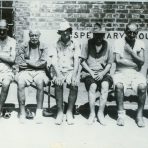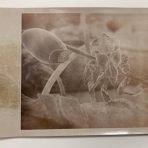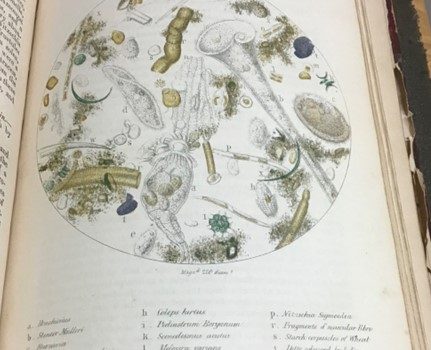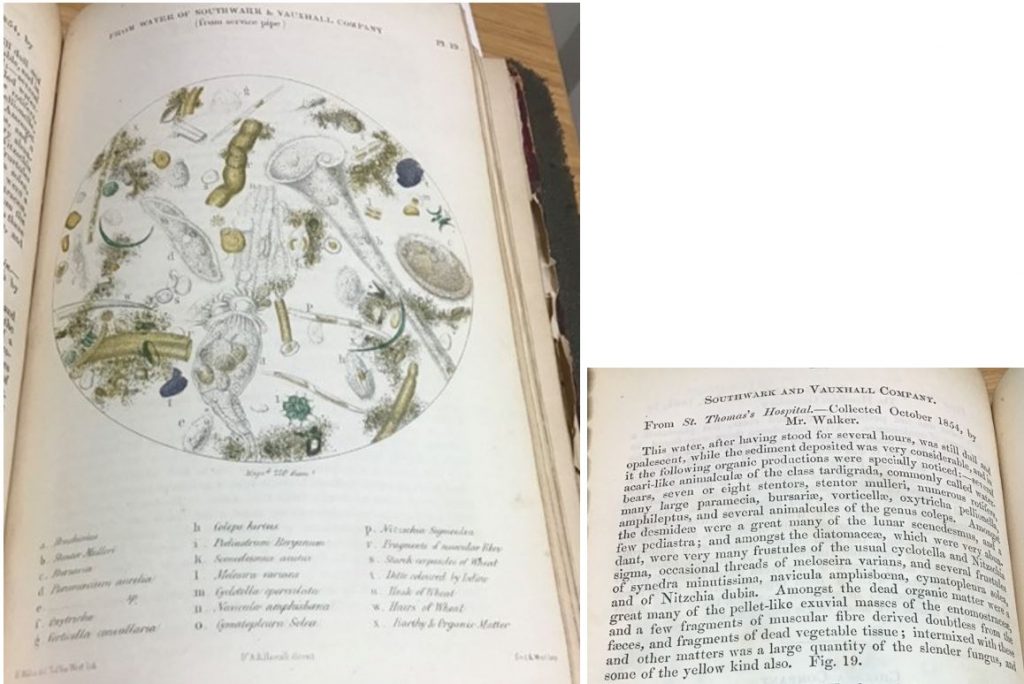
This illustration of a microcosm of the natural world in London’s water in 1854 was published in a book in the School’s Library, Report of the Medical Council … in relation to the cholera-epidemic of 1854 (General Board of Health. Medical Council 1855). It formed part of the evidence gathered for a government investigation at a time when the cause of cholera was unknown and the two main hypotheses for it’s mode of transmission were air pollution and contaminated drinking water. A Scientific Committee of Investigation was tasked with collecting and analyzing meteorological, chemical and microscopical evidence in London. The results were published in 1855.
The man leading the water-borne investigation was Arthur Hill Hassall (1817-1894), a public analyst, microscopist and author of A microscopical examination of the water supplied to the inhabitants of London and the suburban districts (Hassall 1850) which secured his appointment to the cholera enquiry.

Most of London’s water came from the Thames, either fetched directly or pumped out of the river and distributed by commercial water companies. Hassall collected water from the Thames, from the water companies, from residences supplied by the companies where someone had died of cholera, and from wells. Samples were set aside in flasks for several hours to allow solid particles to collect at the bottom. After which they were examined under the microscope and separated into dead and living organic matter, vegetable and animal. The living plants were many and varied including algae and fungi spores. The living animals were of many kinds – protozoans, worms of several species and their eggs, water-fleas and their eggs – which could be seen darting about with great rapidity – even in samples taken from people’s homes! Hassall wrote, “the presence of living organisms in water … is … evidence of impurity and as showing that the water contains constituents on which they can feed and grow” (Hassall 1893 : 61-66). The Thames, as well as supplying London’s drinking water, was also the repository for the discharge of its sewers, creating the ideal environment for micro-organisms to thrive. By contrast, Hassall’s samples taken from wells were mostly free of organic matter : Hassall wrote “… living productions are not contained in the very purest and best waters” (Hasall 1893 : 63).
Hassall’s scientific description of each sample was published in his “Report of the microscopical examination of different waters” (Hassall, 1855a), supplemented by hand-coloured plates of 25 water samples, lithographed by Tuffen West (1823-1891) (Dolan 2021) after drawings by Henry Miller, both of whom had the expertise to interpret and draw to scale organisms under a microscope at a magnification of 200-220 times their natural size. The organisms were identified by Hassall in a key printed below the figures.
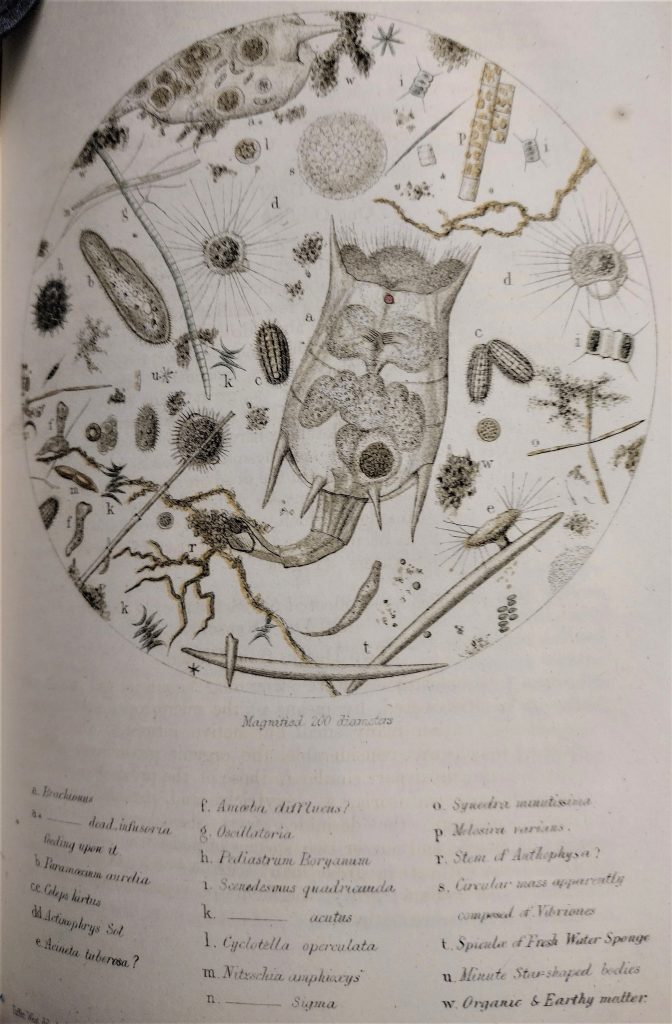
Some samples contained micro-organisms which Hassall could not identify and he called them vibriones (Hassall 1855a: page 228, Plate 3). In a second study Hassall examined evacuations from cholera patients (Hassall, 1855b). Once again, Hassall was not able to identify everything and described : “myriads of vibriones … in every drop of every sample of rice-water discharge” (Hassall 1855b : page 289, Plate 26). The microscope was an invaluable tool in the discovery of pathogenic organisms in the 19th century. Using more sophisticated techniques than Hassall had done, involving staining samples and photomicrography, the bacterium Vibrio cholerae was discovered as the cause of cholera by the German bacteriologist Robert Koch (1843-1910). Koch was working in India in 1884 where patients used the same water for bathing, washing and household cleaning. Later, with the benefit of hindsight, Hassall recognized that he had seen “amongst the small organisms various bacilli, either single or in groups, but which in those days were not discriminated and studied to the extent they now are and the real importance of which was overlooked. However I did not fail to perceive them and to record their presence” (Hassall 1893 : 63). These vibriones, Paul Bingham asserts, were cholera bacteria. Had Hassall studied them thoroughly, he would have been first to discover the cholera bacillus (Bingham 2021 ; Paneth et al 1998 : 1547-1548, 1550).
Hassall’s evidence was not conclusive and the General Board of Health did not accept cholera was a water-borne disease (Paneth et al 1998 : 1549). Koch went on to prove that cholera was transmitted in drinking water contaminated with the faeces of cholera patients. From the work of Koch and others, countries which practice good hygiene, have proper sanitation and a supply of pure water have been able to eliminate cholera.
Arthur Hill Hassall (1817-1894) was born in Teddington, Middlesex and qualified as a physician in 1851. He ran general practices in London and was also a senior physician at the Royal Free Hospital. He wrote a study of British algae (Hassall 1845) and the first textbook in English on human histology (Hassall, 1849). Hassall’s most important contribution to public health was a forensic investigation into food adulteration (Hassall 1855). In 1866 ill-health prompted a move to the Isle of Wight, and in 1878 he moved to Switzerland. Hassall died in San Remo, Italy aged 77.
References:
BINGHAM, Paul, 2021. The greatest missed microscopical opportunity? https://johnsnowsociety.org/files/2021/07/Paul-Bingham-article-on-recognition-of-V-cholerae.pdf
DOLAN, J.R., 2021. Tuffen West, FLS, FRMS (1823-1891) : artist of the microscopic, naturalist, and populariser of microscopy. ISTE OpenScience. 19 pp.
GENERAL BOARD OF HEALTH. Medical Council, 1855. Report of the Medical Council to the Right Hon. Sir Benjamin Hall, Bart., M.P., … in relation to the cholera-epidemic of 1854. London : Printed by George E. Eyre and William Spottiswoode … for Her Majesty’s Stationery Office. (LSHTM Library *JZE 1855).
HASSALL, A.H., 1845. A history of British freshwater Algae. London. 2 vols.
HASSALL, A.H., 1849 . The microscopic anatomy of the human body in health and disease. London : S. Highley.
HASSALL, A.H., 1850. A microscopical examination of the water supplied to the inhabitants of London and the suburban districts. … illustrated by coloured plates. London. (LSHTM Library *SEC.43 1850)
HASSALL, A.H., 1855a. Report on the microscopical examination of different waters (principally those used in the metropolis) during the cholera-epidemic of 1845 (sic). No. VIII, pp. 216-283, 25 plates, in General Board of Health. Medical Council. Appendix to Report of the Committee for Scientific Inquiries in relation to the Cholera-Epidemic of 1854. London : Printed by George E. Eyre and William Spottiswoode for Her Majesty’s Stationery Office. viii, 352 pp. (LSHTM Library *JZE 1855). (NB: The misprint in the title of Hassall’s report in which 1845 is printed incorrectly for 1854).
HASSALL, A.H., 1855b. Report on the microscopical examination of the blood and excretions of cholera patients. No. XI, pp. 289-307, 2 plates in General Board of Health. Medical Council. Appendix to Report of the Committee for Scientific Inquiries in relation to the Cholera-Epidemic of 1854. London : Printed by George E. Eyre and William Spottiswoode for Her Majesty’s Stationery Office. viii, 352 pp. (LSHTM Library *JZE 1855).
HASSALL, A.H., 1855c. Food and its adulterations. London : Longman, Brown, Green, and Longmans. (LSHTM *SFE 1855; https://archive.org/details/b2135554x); Expanded as Food : its adulterations and methods for their detection. London : Longmans, Green, 1876.
HASSALL, A.H., 1893. The Narrative of a busy life : an autobiography. London : Longman, Green, & Co. https://books.google.co.uk/books?id=BGDNAAAAMAAJ&pg=PA61&source=gbs_toc_r&cad=3#v=onepage&q&f=false
PANETH, Nigel, VINTEN-JOHANSEN, Peter, BRODY, Howard and RIP, Michael, 1998. A rivalry of foulness : official and unofficial investigations of the London Cholera Epidemic of 1854. American Journal of Public Health 88 (10) : 1545-1553.
LSHTM Library Rare Books Collection Blogs is an occasional posting highlighting books that are landmarks in the understanding of tropical medicine and public health. The Rare Books Collection was initiated by Cyril Cuthbert Barnard (1894-1959), the first Librarian, from donations and purchases, assisted with grants from the Carnegie United Kingdom Trust. There are approximately 1600 historically important rare and antiquarian books in the Rare Books Collection.
Many of the LSHTM Library’s rare books were digitized as part of the UK Medical Heritage Library. This provides high-quality copyright-free downloads of over 200,000 books and pamphlets for the 19th and early 20th century. To help preserve the rare books, please consult the digital copy in the first instance.
If the book has not been digitized or if you need to consult the physical object, please request access on the Library’s Discover search service. Use the search function to find the book you would like to view. Click the title to view more information and then click ‘Request’. You can also email library@lshtm.ac.uk with details of the item you wish to view. A librarian will get in touch to arrange a time for you to view the item.
Researchers wishing to view the physical rare books must abide by the Guidelines for using the archives and complete and sign a registration form which signifies their agreement to abide by the archive rules. More information is available on the Visiting Archives webpage.


